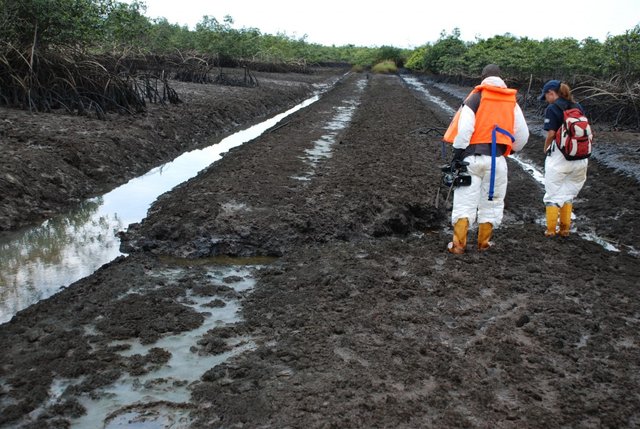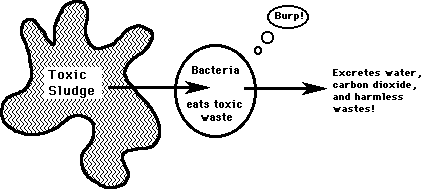Bioremediation for site cleanup
Good morning all and welcome to my Blog
Today post will be part one out of a number of parts. We are going to discuss Bioremediation today.

Source
Many of you have been to mechanic workshops, oil producing areas, you can see how oily, blacky the ground there are.
You ever asked yourself Can this be cleaned, Can this place ever come back to its normal state. Well I tell you it can be reversed to its normal state, previous state through Bioremediation.
I was taught, and fully understand Bioremediation in my third year in the university, it is a fascinating topic that helps us appreciates the efforts of microorganisms.
It shows that not all microorganisms are bad, but some are actually good and useful to the Human cause.
What is Bioremediation?

Source
Bioremediation is simply the use of Microbes (Bacteria, Fungi etc.) to break-down/degrade the harmful chemicals in the environment. The environment here refers to water, soil, and any contaminated materials.
You might be wondering, how does this happen, where do the harmful chemicals go, what do they turn to. The microrganisms absorb and metabolize this harmful chemicals to produce water, biomass, and carbondioxide which are not harmful to the environment.
However, the microorganisms may breakdown this harmful chemicals to less harmful ones that is innocuous metabolites.
Sometimes the microorganisms do not completely breakdown a harmful substance, thus it will lead to the production of a more harmful/toxic compound/chemical. For example Trichloroethylene (TCE) may form Vinyl Chloride which is a carcinogen Source.
Before using Bioremediation to clean up a site, there are some things to consider. You don’t just see a contaminated area and start Bioremediation, there are some factors that you will consider.
Factors to consider before suggesting Bioremediation for cleaning up a contaminated site
- The type of contaminants/harmful chemicals/harmful compounds at the site
- The concentrations of the contaminants/harmful chemicals/harmful compounds at the site, this will enable you to know how large or small is the dissolved contaminant at the site
- The movement of harmful chemicals/contaminants in the future. In a situation like oil spillage on the sea, water you have to take into consideration, the movements of the oil, how it spreads so as to have an effective Bioremediation process.
- Contaminants Degradability: this is a measure of how fast or slow the contaminant can degrade/breakdown. Contaminants like Petroleum and its hydrocarbons have high degradability because they exists naturally in the environment. However, some contaminants have slow degradability, they breakdown slowly. Examples of this type of contaminants are those that their structures are very complex, and their ring structures also have halogen compounds in place of other compound.
- The rate of the contaminant breakdown/degradation should be able to reduce the contaminants to an acceptable level.
If all these factors returns a positive results, then you can now proceed with using Bioremediation to clean up a contaminated site.
For every being in life there is an advantage and disadvantage
Bioremediation is no exception, it has its own advantages and disadvantages
Advantages of Bioremediation
- Lower cost than traditional processes. The cost is much lesser than orthodox technologies like using dispersants, the boom and skim method. Here you just need the microorganisms to work for you.
- The contaminants are changed to less harmful substances.
- It is easy to implement. You don’t need technical skills to be able to carry out the process.
Disadvantages of Bioremediation
- The microorganisms introduced to remove the contaminants may cause other problems, like the formation of a more harmful contaminant.
- It may be hard to control.
- It is not something that will produce result in minutes, or hours. It requires time.
- The world is dynamic, so are microorganisms, so it is difficult to predict future efficacy.
The next part will talk about the types of Bioremediation Technologies that we have.
Some Ideas gotten from
Link
Others are solely my write-up.
Kindly Follow, Upvote, Comment, and Resteem if you like this Post
Certainly a masterpiece bro!
Thank you Sir. We are results of your leadership
Interesting post!
Improve the quality of your posts.
Thanks for the comment. I am open to corrections. How can I improve, kindly tell me
This is an interesting read. Looking forward to more from you bro.
Enlightening @zoneboy, can bioremediation be use for Ogoja clean-up?
Yes. It can
I knew about bioremediation but this info helped me to know much more about it. Good post!
This post has received a 0.51 % upvote from @booster thanks to: @zoneboy.
This post has received a 0.50% upvote from @morakinyo thanks to: @zoneboy.